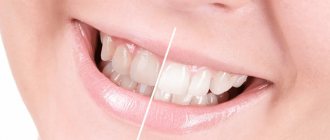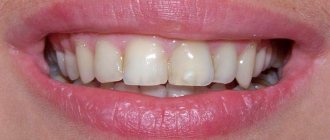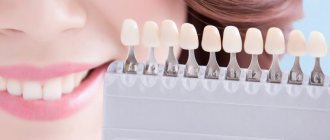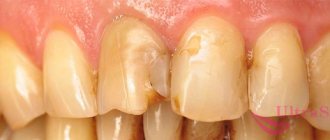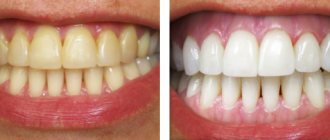Causes of darkening of enamel
- Eating foods and drinks containing dyes;
- Having bad habits such as smoking;
- Past illnesses;
- Age-related changes in the human body.
If it is possible to compensate for the insufficient whiteness of teeth associated with the individual characteristics of the tooth structure only by using crowns, veneers and onlays, then compensation for darkening caused by external factors does not require such serious intervention. Modern cosmetic dentistry has a fairly large selection of methods and means for whitening tooth enamel.
In the question “ what is the safest and most effective teeth whitening ,” it is worth considering that the possible risks and complications of such procedures cannot be underestimated. Like any intervention, whitening has its indications and contraindications.
Contraindications for teeth whitening
- Age under 18 years;
- Individual intolerance (allergic reactions) to the components of substances used in the bleaching process;
- Pregnancy and breastfeeding;
- Completing a course of chemotherapy;
- Undergoing treatment with light-sensitive drugs (tretinoin, tetracycline antibiotics, etc.);
- Untreated caries and other destruction of dental units;
- Wedge-shaped tooth defects;
- Exposure of the neck of the dental units;
- Artificial crowns;
- Areas that have undergone filling or restoration, located in the area of intended bleaching;
- Periodontitis in the acute phase;
- Various wound lesions of the oral mucosa;
- The presence of a pronounced gag reflex.
Risks of bleaching
- Increased sensitivity of tooth enamel;
- Changes in the structural state of the enamel;
- Possibility of premature wear of teeth;
- Changes in enamel strength, increased fragility and brittleness;
- Irritation of the mucous membranes located in close proximity to the procedure site.
It is in connection with the above factors that many people are interested in the question of which teeth whitening is the safest and most effective . There are two main whitening options:
- Dental;
- Homemade.
In both cases there are nuances that must be taken into account.
Advantages and disadvantages of the procedure
Positive sides:
- Quick results. In a single visit, you can noticeably lighten the enamel by several tones, the effect depends on its condition.
- No medical indications. The client of the dental clinic decides for himself whether he needs to whiten his teeth.
- Many methods with different effects and prices.
- No pain or other discomfort.
- Almost all methods are universal, which means they can be used for patients of different ages.
- There is no need to go through a recovery period.
- Getting rid of complexes and awkwardness when communicating with others.
The technique also has negative aspects:
- The most effective methods have a high cost.
- The effect does not last long. The smile will remain snow-white for 5-7 years, but no more.
- Increased sensitivity of enamel, its thinning. Pain may occur while eating if the food or water is too cold or too hot.
- Inability to change the color of filling material, implants, artificial crowns.
- The risk of losing the natural shade of teeth and excessive whiteness increases.
- The need to adhere to dietary nutrition to maintain results. It is not recommended to drink coffee, strong black tea, or eat foods with a high concentration of bright natural pigment.
Difference between teeth whitening and teeth lightening
Before choosing the safest and most effective method of teeth whitening, it is worth understanding the difference between teeth whitening and teeth lightening - what is the difference between them? The main differences between these concepts come down to the following points:
- >Teeth whitening involves a chemical reaction to break down plaque. During the procedure, special oxidizing agents are used that penetrate the upper layers of enamel, giving a light shade to the teeth.
- The whitening procedure is different in that it is less chemically destructive and does not use many chemicals, however, the result will not be as effective and long-lasting as with teeth whitening.
By lightening, dentists mean gentle mechanical and abrasive methods of removing plaque. They do not use hydrogen peroxide and other compounds, but the result will not be as effective and durable. Based on this, we can conclude that teeth whitening has a number of bad consequences: uneven color, increased tooth sensitivity, and in rare cases, burns to the tissue of the lips or gums. However, today there are many safe and effective ways to whiten teeth , both in dentistry and at home.
Methods of teeth whitening in dentistry
In this case, all procedures are carried out by a specialist in a clinical setting, using professional tools, equipment and techniques.
Mechanical whitening method
The whitening process uses specialized tools and attachments that effectively remove plaque and tartar deposits. At the moment, the most common methods of mechanical cleaning are recognized: ultrasonic cleaning and Air Flow sandblasting. It is difficult to call such procedures whitening, since they first of all remove deposits from the surface of the teeth and restore their natural color, eliminating nicotine plaque and the remains of coloring food fragments. This type of treatment involves exposing the tooth to a powerful, focused water-air jet containing abrasive particles. As a result of processing, the enamel is lightened by 6-7 tones and acquires a polished surface.
This type of teeth whitening is quite effective , as you can see a fairly quick effect and a low price.
Laser whitening
The essence of the procedure lies in the interaction of hydrogen peroxide and a laser beam, which serves as a kind of amplifier of the effect of the substance. In addition to the above, the laser makes the procedure the safest due to its ability to accelerate the process of peroxide penetration into the tooth enamel. Stages of the procedure:
- Examination and assessment of the condition of the oral cavity for the presence (absence) of contraindications.
- Removing plaque and tartar deposits;
- Applying a gel containing high concentration hydrogen peroxide.
- Laser treatment at the rate of 30 seconds of exposure to each dental unit.
- Cleaning the oral cavity.
- Mineralization of enamel using fluoride-containing preparations.
Why is laser teeth whitening effective?
- Short time of impact. Unlike light whitening, which can last from 1 to 2 hours, the laser whitening procedure takes on average 30-40 minutes.
- High quality whitening, allowing you to achieve quick results with lightening by 8-10 tones on the Vita scale, and long-lasting results, varying from 3 months to a year or more.
- Relative harmlessness. The speed of exposure of the composition and the laser beam allows you to reduce the harmful effects on the enamel.
- Laser exposure has a disinfecting effect, which is the prevention of many diseases, including caries.
- Several laser treatments can not only whiten teeth, but also give them smoothness, due to which further staining of the enamel is significantly reduced.
- Mineralization, carried out at the end of the procedure, does not increase the sensitivity of the enamel, on the contrary, it strengthens and revitalizes it.
- Painless procedure.
Disadvantages of laser teeth whitening
- Relative negative aspects include the fairly high cost of the procedure.
- Smoking may minimize the results.
- An incorrectly performed procedure can lead to burns of the mucous membranes, damage to the enamel and increased sensitivity. the safest and most effective teeth whitening service, you can contact our clinic
Contraindications for laser whitening
- Deep and extensive damage to the enamel (caries, cracks, erosion, etc.);
- Availability of corrective and restorative systems (braces, veneers, dentures);
- Inflammation of the gums;
- Exposure of the root part of the teeth.
Photobleaching
The method is based on the combined effect of a specialized brightening composition containing hydrogen peroxide and urea and a light emitter that acts as an activator.
The following light sources can be used:
- LED lamps, cold glow. This type of lamp is recognized as one of the safest;
- Halogen lamps provide cold light, minimizing tissue injury;
- Ultraviolet lamps. Such lamps are now not often used, as they give an excessively heating effect.
The type of lamp is selected depending on the individual characteristics and type of structure of the teeth. One session of such whitening can last from 30 minutes to 1-2 hours, depending on the complexity, and lighten the enamel by 7-10 tones. The maximum effect is achieved after 3 sessions.
Photobleaching technologies
- Zoom technology. An important nuance of this technology is the addition of calcium phosphate to the lightening composition, which has a strengthening effect on the enamel. In this case, transillumination is carried out with an ultraviolet lamp. The maximum efficiency of this technology is lightening by 12 tones. UV lamps have a pronounced warming effect, but the high efficiency of teeth whitening of this type makes this technique quite popular;
- Amazing White technology. The targeted effect of the LED lamp breaks down peroxide molecules into oxygen, which brightens dentin and water;
- Beyond Polus technique. Involves a combination of halogen and LED lighting. Such interaction makes the procedure more gentle and safe. The procedure includes three cycles, 10 minutes each. The results obtained can last up to 12 months;
- Luma Cool technology. LED lamps with cold light are used. The session consists of three cycles, lasting 8 minutes. Exposure to LEDs is one of the safest and most gentle. The achieved result can last for several years.
Indications for photobleaching:
- Uniform darkening of the enamel without spots or pronounced stripes.
Contraindications to the procedure
- Pregnancy and breastfeeding;
- Age less than 18 years;
- The presence of thinned enamel with increased sensitivity;
- Carious lesions of dental tissues.
Benefits of photobleaching
- Rapid achievement of results that last for a period of 1 to 3 years;
- Photo whitening is extremely one of the safest methods of teeth whitening .
Negative sides
- Increased sensitivity of the enamel during the first time after the procedure;
- Does not have a brightening effect on foreign inclusions and systems (fillings, veneers, dentures);
- Quite a high price.
Photobleaching process
- Examination of the patient’s oral cavity and assessment of the patient’s condition in order to identify possible contraindications;
- Removing plaque and tartar deposits;
- Isolate the gums with a sterile film or protective gel and a lamp to prevent burns and irritation that may result from contact with the bleaching agent;
- The eyes of the patient and the doctor are protected with special glasses;
- Application of whitening gel. The gel is distributed in an even layer on the teeth of both jaws;
- The gel is irradiated by a lamp. The average session duration is about 30 minutes. The exposure time may decrease or increase depending on the desired result and the original shade;
- At the end of the procedure, the remaining gel is removed from the oral cavity;
- The number of repeated treatments is 3-4 sessions, depending on the desired result. The assessment is made using the Vita scale;
- The patient receives advice on care, allowing the results to be maintained for as long as possible.
On average, the result of such treatment can last from 1 to 3 years.
Chemical bleaching
The method is based on the impact on darkened enamel with various gel-like agents, which include carbamide or hydrogen peroxide, the percentage of which can vary from 10 to 45%. The methods of photobleaching and laser cleaning described above can essentially be considered varieties of chemical techniques, since all three methods use gels containing peroxide. The main distinguishing feature of these methods is the mandatory presence of a laser or light lamp, which makes it possible to achieve the desired results when using peroxide in much smaller proportions. While the chemical method does not involve the use of auxiliary equipment, whitening occurs solely due to the composition applied to the surface of the teeth.
The chemical bleaching method is considered more gentle compared to laser or photo bleaching due to the absence of heating devices. However, the result of such bleaching is much less pronounced and amounts to approximately 5-6 tones. The procedure takes 60 minutes, and the achieved effect lasts from 1 to 1.5 years.
Indications for chemical teeth whitening
- Darkening of the enamel as a result of consuming foods (drinks) containing aggressive dyes;
- Tobacco smoking;
- Darkening of the enamel as a result of long-term use of certain medications;
- Age-related changes in enamel;
- Damage to the enamel and its darkening as a result of injury.
Contraindications
- The presence of high enamel sensitivity;
- Serious damage to the enamel layer (cracks, chips);
- Presence of untreated diseases of teeth and gums;
- Individual intolerance to the components of the lightening gel.
Stages of the procedure
- Examination of the patient’s oral cavity to determine the possibility of whitening;
- Isolation of gums using protective pads to prevent gel from entering, which can cause a burn;
- The teeth are isolated from the oral cavity to avoid saliva;
- Application of gel. The composition is applied using a special brush, evenly and layer by layer;
- After the required exposure is completed, the remaining gel is carefully removed.
Positive properties of the chemical lightening bleaching method
- Quick result, the beginning of which is noticeable after 15 minutes, and the final result is visible after 30-60 minutes;
- Relative safety, due to the absence of additional traumatic devices;
- Painless procedure.
Flaws
- The development of excessive reactivity on the part of the enamel is possible;
- Selectivity of the method;
- Risk of irritation or burn of the gums in case of contact with the bleaching composition.
Endobleaching (intracanal method)
Intra-canal bleaching, compared to the above, is a more coordinated measure and is used in cases where the darkening of the enamel is associated not with external, but with internal factors. The most common reason for endo-whitening is darkening of the tooth crown from the inside. This can happen as a result of depulpation, the use of coloring filling materials, dental disease (pulp necrosis, pulpitis, pulp hemorrhage, hypercalcification) and serious injury to the crown of the tooth. The essence of the method is to inject a dye into the crown and then seal the entrance hole.
Indications for intra-canal bleaching
- Age-related darkening;
- Darkening associated with bad habits;
- Incorrect treatment carried out earlier and causing darkening of the tooth from the inside;
- Darkening associated with total injury to the internal tissues of the tooth.
Contraindications
- Pregnancy and breastfeeding;
- Age up to 18 years;
- Periodontitis;
- High level of enamel sensitivity;
- Diabetes;
- Thyroid diseases;
- Advanced carious lesions;
- Individual intolerance to the components of the composition;
- Inflammatory diseases of the oral cavity.
Advantages of the method
- Possibility of restoring the aesthetic appeal of teeth without prosthetics or installing veneers;
- Minimum possibility of complications;
- Relative painlessness;
- High performance, allowing you to achieve whitening by 10-12 tones;
- Relatively low cost;
- Long lasting results.
Disadvantages of endobleaching
- Using a drill;
- The appearance of fragility with frequent use of the method;
- Replacement of old filling material is required;
- The procedure may require several visits to the doctor.
It should be borne in mind that this method requires more thorough preparation than those previously described. One of the first stages of preparation is an x-ray examination, which allows you to clearly assess the problem and condition of the teeth. After the examination, a thorough visual examination and complete sanitation of the patient’s oral cavity are performed.
Stages of endobleaching
- Treatment of the oral cavity with an antiseptic;
- Selection of a suitable shade of enamel;
- Isolation of the tooth to be whitened;
- Removing old filling material;
- Thorough sanitation of the cavity;
- Isolation of canal mouths using a special lining;
- Introduction of a brightening agent into the prepared cavity;
- Sealing with installation of a temporary filling.
A repeat procedure is scheduled after 7 days. A total of 2 to 4 visits may be required. When the desired result is achieved, the doctor installs a permanent filling.
Due to the fact that the intracanal bleaching method involves deep intervention, the recommendations that should be followed are more serious.
So, in the first 7-10 days after the procedure it is not recommended:
- Give serious mechanical loads to the tooth being whitened;
- Eat foods that are sharply contrasting in temperature;
- Use viscous, enveloping foods and chewing gum;
- Chew actively on the side where bleaching was performed.
Recommendations after whitening
Features of caring for teeth and maintaining their “shape” depend on the type of whitening. Moreover, before the procedure it is necessary to carry out a number of preparatory manipulations.
- Examination of the oral cavity, X-ray examination and identification of possible contraindications. These include cancer, diabetes, allergies to ultraviolet radiation, and active dental diseases. Whitening is also contraindicated for pregnant women and people under 18 years of age.
- Professional oral cleaning.
- In-office whitening usually requires one procedure. After this, remineralizing therapy is carried out, which will restore the enamel after the procedure. To consolidate the results, a course of home whitening is prescribed, which can last up to a month. If the patient wants to undergo only a course of home whitening, he also needs to consult with a doctor, who will also help him choose the optimal system.
The most effective teeth whitening at home
Teeth whitening at home is a fairly common type of hygiene care. The modern market offers a fairly rich assortment of whitening products that differ in effectiveness and price ranges, so it is definitely impossible to answer the question: “ what is the most effective teeth whitening at home ”? It is worth considering that all home remedies, both improvised and manufactured in industrial conditions, will not allow you to achieve the same dramatic results that can be obtained with professional whitening in a clinic. In addition, with careless and extremely intensive use of such products, there is a high probability of causing serious damage to tooth enamel and nearby tissues. This is due to the abrasives contained in pastes and other bleaching agents and the presence of irritating components, such as hydrogen peroxide. With frequent use, abrasive particles can thin the enamel and leave microdamages, which become a favorable environment for the accumulation of bacteria and staining particles. Hydrogen peroxide, if used incorrectly, can seriously injure mucous membranes, leaving burns and irritation.
Toothpastes with a whitening effect, gels, trays and pencils have gained the most popularity as some of the most effective ways to whiten teeth at home Currently, in pharmacies you can find various whitening pastes, which contain substances that gently and effectively remove plaque. You should use them no more than 1-2 times a week, since the abrasive particles contained in the paste spoil the enamel, and subsequently it can be easily stained by coffee, tea and other products.
How does the procedure work?
The main preparation before the whitening procedure, which guarantees uniform lightening of the enamel, is teeth cleaning (“Air Flow” and ultrasound). Professional whitening is carried out in a regular dental chair. Initially, it is necessary to isolate the mucous membrane so that the bleaching agent does not come into contact with it. Next, the doctor applies it to the teeth (for about 20 minutes) and uses a special lamp. This procedure is repeated several times, completely washing off the composition. The average duration of the entire procedure is 1.5 hours. It does not cause any painful sensations. Some patients feel a slight tingling sensation - this is a normal reaction.
The procedure has a cumulative effect - oxygen continues to work on the teeth behind the doors of the dental office. The final result can be assessed after 1-2 weeks. It is important to adhere to a “white” diet for the first 2-3 days after the procedure: give up coffee, black tea, red wine and any coloring products. The resulting effect will last about 2-3 years (if you regularly sign up for professional hygiene every six months).
Which teeth whitening is the safest and most effective: summary
When choosing which teeth whitening is the safest and most effective , you need to understand that it is almost impossible to achieve high results without the risk of damaging the enamel or the tooth as a whole at home. That is why it is more advisable to entrust this procedure to professional doctors.
If we talk about the safest and most effective teeth whitening in dentistry, then it is hardly possible to answer this question unambiguously, since any method has its pros and cons. The choice of whitening method is selected individually and is based on many aspects and nuances.
Composition of whitening gels
For various methods of professional and non-professional teeth whitening, special whitening gels are used, the active substances of which are hydrogen peroxide or carbamide. Sometimes the preparations include amorphous calcium phosphate, fluoride or potassium nitrate to treat minor damage to the enamel, as well as to make teeth brighter and glossier after the procedure. In some cases, the whitening gel may contain special components that have a soothing effect on the teeth and gums.
